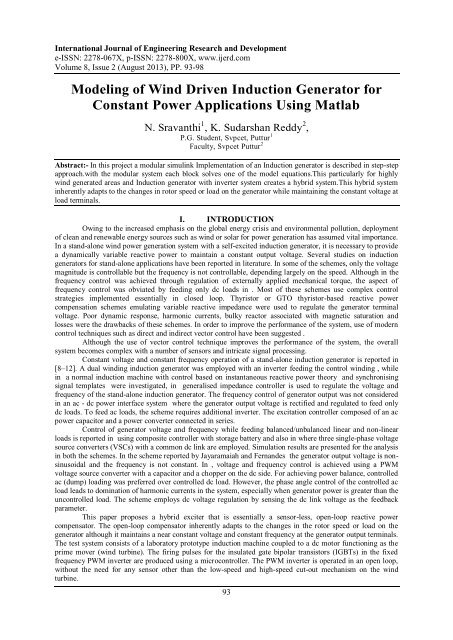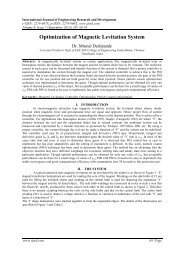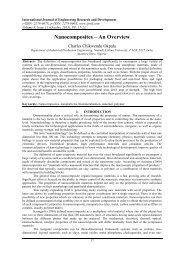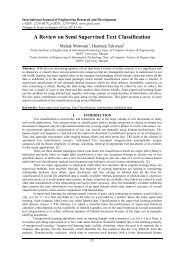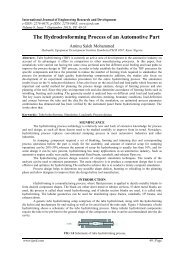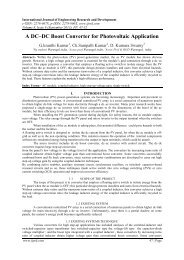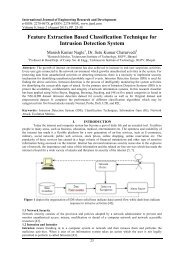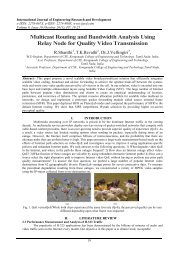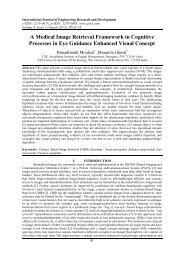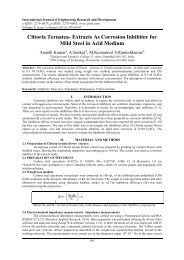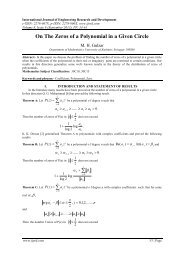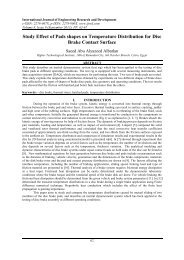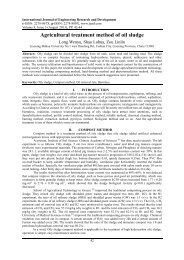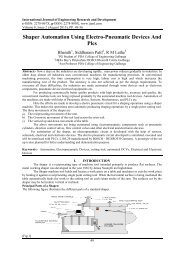L08029398.pdf
You also want an ePaper? Increase the reach of your titles
YUMPU automatically turns print PDFs into web optimized ePapers that Google loves.
International Journal of Engineering Research and Development<br />
e-ISSN: 2278-067X, p-ISSN: 2278-800X, www.ijerd.com<br />
Volume 8, Issue 2 (August 2013), PP. 93-98<br />
Modeling of Wind Driven Induction Generator for<br />
Constant Power Applications Using Matlab<br />
N. Sravanthi 1 , K. Sudarshan Reddy 2 ,<br />
P.G. Student, Svpcet, Puttur 1<br />
Faculty, Svpcet Puttur 2<br />
Abstract:- In this project a modular simulink Implementation of an Induction generator is described in step-step<br />
approach.with the modular system each block solves one of the model equations.This particularly for highly<br />
wind generated areas and Induction generator with inverter system creates a hybrid system.This hybrid system<br />
inherently adapts to the changes in rotor speed or load on the generator while maintaining the constant voltage at<br />
load terminals.<br />
I. INTRODUCTION<br />
Owing to the increased emphasis on the global energy crisis and environmental pollution, deployment<br />
of clean and renewable energy sources such as wind or solar for power generation has assumed vital importance.<br />
In a stand-alone wind power generation system with a self-excited induction generator, it is necessary to provide<br />
a dynamically variable reactive power to maintain a constant output voltage. Several studies on induction<br />
generators for stand-alone applications have been reported in literature. In some of the schemes, only the voltage<br />
magnitude is controllable but the frequency is not controllable, depending largely on the speed. Although in the<br />
frequency control was achieved through regulation of externally applied mechanical torque, the aspect of<br />
frequency control was obviated by feeding only dc loads in . Most of these schemes use complex control<br />
strategies implemented essentially in closed loop. Thyristor or GTO thyristor-based reactive power<br />
compensation schemes emulating variable reactive impedance were used to regulate the generator terminal<br />
voltage. Poor dynamic response, harmonic currents, bulky reactor associated with magnetic saturation and<br />
losses were the drawbacks of these schemes. In order to improve the performance of the system, use of modern<br />
control techniques such as direct and indirect vector control have been suggested .<br />
Although the use of vector control technique improves the performance of the system, the overall<br />
system becomes complex with a number of sensors and intricate signal processing.<br />
Constant voltage and constant frequency operation of a stand-alone induction generator is reported in<br />
[8–12]. A dual winding induction generator was employed with an inverter feeding the control winding , while<br />
in a normal induction machine with control based on instantaneous reactive power theory and synchronising<br />
signal templates were investigated, in generalised impedance controller is used to regulate the voltage and<br />
frequency of the stand-alone induction generator. The frequency control of generator output was not considered<br />
in an ac - dc power interface system where the generator output voltage is rectified and regulated to feed only<br />
dc loads. To feed ac loads, the scheme requires additional inverter. The excitation controller composed of an ac<br />
power capacitor and a power converter connected in series.<br />
Control of generator voltage and frequency while feeding balanced/unbalanced linear and non-linear<br />
loads is reported in using composite controller with storage battery and also in where three single-phase voltage<br />
source converters (VSCs) with a common dc link are employed. Simulation results are presented for the analysis<br />
in both the schemes. In the scheme reported by Jayaramaiah and Fernandes the generator output voltage is nonsinusoidal<br />
and the frequency is not constant. In , voltage and frequency control is achieved using a PWM<br />
voltage source converter with a capacitor and a chopper on the dc side. For achieving power balance, controlled<br />
ac (dump) loading was preferred over controlled dc load. However, the phase angle control of the controlled ac<br />
load leads to domination of harmonic currents in the system, especially when generator power is greater than the<br />
uncontrolled load. The scheme employs dc voltage regulation by sensing the dc link voltage as the feedback<br />
parameter.<br />
This paper proposes a hybrid exciter that is essentially a sensor-less, open-loop reactive power<br />
compensator. The open-loop compensator inherently adapts to the changes in the rotor speed or load on the<br />
generator although it maintains a near constant voltage and constant frequency at the generator output terminals.<br />
The test system consists of a laboratory prototype induction machine coupled to a dc motor functioning as the<br />
prime mover (wind turbine). The firing pulses for the insulated gate bipolar transistors (IGBTs) in the fixed<br />
frequency PWM inverter are produced using a microcontroller. The PWM inverter is operated in an open loop,<br />
without the need for any sensor other than the low-speed and high-speed cut-out mechanism on the wind<br />
turbine.<br />
93
Modeling of Wind Driven Induction Generator for Constant Power…<br />
The paper is arranged as follows: Section 2 describes the principle of operation of the proposed control<br />
scheme; Section 3 explains the dynamic and the steady-state analysis of the system; Section 4 presents the<br />
results and discussion and the overall conclusions from the study are given in Section 5.<br />
II. PRINCIPLE OF OPERATION<br />
Fig. 1 describes the scheme of wind turbine-driven induction generator with the proposed hybrid<br />
exciter. A squirrel cage induction machine is used as a generator, with excitation provided from two sources,<br />
viz., one fixed capacitor bank and a parallel connected inverter. The dc bus of the inverter is supported by a<br />
battery. In the absence of the parallel inverter, if the wind speed is above the cut-in speed but lower than the<br />
nominal synchronous speed, the self excited induction generator (SEIG) generates less than nominal voltage.<br />
This is because the fixed capacitors are selected to meet only the base-level requirement of excitation var.<br />
However, in the proposed set-up, the pre-charged battery (with a desired voltage) feeds the inverter that<br />
provides the necessary additional lagging reactive power to the induction generator so as to develop the nominal<br />
output voltage at lower speeds and higher loads. The lagging reactive current and the reactive power drawn from<br />
the inverter depend upon the voltage differential between the inverter output (that is maintained constant) and<br />
the generated voltage of the induction machine and thus is a self-regulating mechanism considering that the dc<br />
input voltage of the inverter is maintained adequate for supplying reactive power. In addition, because of the<br />
provision of the battery, the inverter is capable of supplying a limited real power also to the SEIG or/and the<br />
load during sub-synchronous speed conditions. Further, as the speed approaches synchronous speed and<br />
increases further, the real power supplied by the inverter decreases in magnitude before becoming negative. The<br />
reactive power supplied by inverter reduces with increasing speed because of the presence of the fixed<br />
capacitors. Thus, the inverter contributes mainly to the balance of excitation var needed by the generator (in<br />
addition to that supplied by the fixed capacitors) at the given speed and load condition. Further, since the dc bus<br />
of the inverter is connected to the battery, the inverter can exchange a limited real power also.<br />
Fig.1. Schematic diagram of SEIG in open loop with hybrid exciter<br />
When the rotor speed is greater than the synchronous speed of the machine (corresponding to the<br />
inverter output frequency), the generator supplies real power to the load. Thereon, the inverter functions as a<br />
virtual grid, supplying only the balance reactive power to the machine, although the output frequency and<br />
voltage are maintained constant by the inverter. By maintaining the battery (dc bus) voltage adequately high, the<br />
inverter can be made to supply the balance lagging reactive power needed by the machine and the load<br />
combination. Thus, for wind speeds above the synchronous speed, the system functions similar to the gridconnected<br />
wind electric generator, supplying real power to the connected load while drawing the balance<br />
reactive power from the grid (inverter in the present case) as needed at the particular speed and load conditions.<br />
At a given speed, when the load increases, the generator terminal voltage tends to dip. At this instance<br />
because of increased voltage difference, increased current is automatically supplied by the inverter to meet the<br />
new requirement. Similarly when the load is decreased, the terminal voltage rises and hence the current drawn<br />
from the inverter is reduced naturally. If the load is removed, then the inverter draws current from the generator.<br />
Overall, the changes in load and speed primarily affect the generator terminal voltage only. An imposed<br />
constant output voltage at the inverter serves to provide a dynamically varying reactive compensation to the<br />
generator–load combination. On the other hand, the generator frequency is tied to the inverter output frequency<br />
that is kept constant in the firing circuit.<br />
III. ANALYSIS OF SYSTEM PERFORMANCE<br />
In this section, the theoretical basis for predicting the dynamic and the steady-state performance of the<br />
wind power generating system with the hybrid exciter is explained.<br />
3.1. DYNAMIC MODELING<br />
Fig. 2 shows the schematic of the system under study. A squirrel cage induction machine is used as a<br />
generator, with excitation provided from two sources, viz., one fixed capacitor bank and a parallel connected<br />
94
Modeling of Wind Driven Induction Generator for Constant Power…<br />
inverter. The dc bus of the inverter is supported by a battery and the inverter is operated at a fixed frequency<br />
suitable for the induction machine.<br />
(a) Mathematical model of the induction machine<br />
The dynamic equations governing the stator and the rotor<br />
currents in the stator flux coordinates can be written as follows [20, 21]:<br />
a) d-axis model<br />
b) q-axis system model<br />
(b) Modeling of excitation system<br />
Fig. 2. Equivalent circuit of system<br />
(i) Capacitor: The state equations of fixed capacitor bank are derived using the d – q components of stator<br />
voltage as state variables from the circuit shown in Fig. 2.<br />
(ii) Inverter – battery system: Using the d – q components of inverter current as state variables the following<br />
differential equations are derived from the circuit shown in Fig. 2.<br />
(c) Resistive load: The d– q axes current equations for the balanced resistive load can be given by<br />
95
Where<br />
Modeling of Wind Driven Induction Generator for Constant Power…<br />
IV. SIMULATION RESULTS<br />
Fig 4.1: Torque characteristics of induction machine operating as generator<br />
Fig. 4.2 Speed vs time characteristics<br />
Fig. 4.3 Inverter voltage<br />
96
Load Voltage(Volts)<br />
600<br />
400<br />
200<br />
0<br />
-200<br />
-400<br />
Modeling of Wind Driven Induction Generator for Constant Power…<br />
Fig.4.4. Stator current of the induction generator<br />
Load Voltage(Volts)<br />
2 2.5 3 3.5<br />
x 10 4<br />
-600<br />
Time(sec)<br />
4.5 .Load voltage<br />
V. CONCLUSION AND FUTURE WORK<br />
The standalone operation of induction generator is discussed in detail. The SEIG is connected to the<br />
VSI and battery energy storage system. The reactive power to the generator is supplied by the capacitor bank<br />
and the VSI. The mathematical modeling of overall inter connection is modeled using the basic mathematical<br />
equations.<br />
If the input (wind velocity for the wind turbine) to the generator is low the generator output will be low.<br />
If the generated output is less than the connected load the battery will supply the power to the load. If the load is<br />
inductive the reactive power is supplied by the voltage source inverter to reach the requirement.<br />
Thus the above discussed system can be used in remote locations where the transmission system is not<br />
economical. So the stand alone application of SEIG gained importance in modern usage.<br />
Future work is to implement same proposed scheme along with boost converter and PV panel.<br />
REFERENCES<br />
[1] A. Karthikeyan C. Nagamani G. Saravana Ilango A. Sreenivasulu Hybrid, open-loop excitation system<br />
for a wind turbine-driven stand-alone induction generator “International conference on power<br />
Electronics Vol.No.99,April2011”<br />
[2] S. Wade, M. W. Dunnigan, B. W. Williams, “Modeling and simulation of induction machine vector<br />
control with rotor resistance identification,” IEEE Transactions on Power Electronics, vol. 12, no .3,<br />
May 1997, pp. 495 -506<br />
[3] B. Ozpineci, B.K. Bose, "A soft-switched performance enhanced high frequency non-resonant link<br />
phase-controlled converter for ac motor drive," The 24th Annual Conference of the IEEE Industrial<br />
Electronics Society (IECON'98), Aachen/Germany, 1998, vol. 2, pp 733-749<br />
[4] H. Le-Huy, “Modeling and simulation of electrical drives using Matlab/Simulink and Power System<br />
Blockset,” The 27th Annual Conference of the IEEE Industrial Electronics Society (IECON'01),<br />
Denver/Colorado, pp. 1603-1611.<br />
[5] Y. Kang and J.D. Lavers, “Transient Analysis of Electric Power Systems: Formulation and Theoretical<br />
Basis,”IEEE Transactions on Power Systems, Vol. 11, No. 2, pp.754-760, May 1996<br />
[6] N. Mohan, W.P. Robbins, L.A. Aga, M. Rastogi, and R. Naik, “Simulation of Power Electronics and<br />
Motion Control Systems,” chapter 8 in Power Electronics and Variable Frequency Drives, Edited by<br />
B.K. Bose, IEEE Press, New York 1997, pp. 400-453<br />
97
Modeling of Wind Driven Induction Generator for Constant Power…<br />
[7] M.F. Rahman, L. Bong and K. W. Lim," A direct torque controlled interior magnet synchronous motor<br />
drive incorporating field weakening", 'I Industrial Applications, IEEE Transactions on, Vol. 34 No. 6<br />
pp. 1246-1253, Nov./Dec. 1998<br />
[8] lsao Takahashi and Ohmori, Y." High-performance direct torque control of an Induction motor"<br />
Industrial Applications, IEEE Transactions on, Volume 25 Issue 2 March-April 1989<br />
[9] Hegde, R.K.: „A wind driven self excited induction generator with terminal voltage controller and<br />
protection circuits‟IEEE Int Conf.on Power Conversion April 99.<br />
[10] Bhim, S., Gaurav kumar, K.: „Solid state voltage and frequency controller for a stand alone wind power<br />
generating system‟, IEEE Trans. Power Electron., 2008, 23, (3), pp. 1170–1177<br />
[11] Venkatesa Perumal, B., Jayanta, K.: „Voltage and frequency control of a stand alone brushless wind<br />
electric generation using generalized impedance controller‟, IEEE Trans. Energy Convers., 2008, 23,<br />
(2), pp. 632–641.<br />
[12] Singh, B., Murthy, S.S., Gupta, S.: „STATCOM-based voltage Regulator for self-excited induction<br />
generator feeding nonlinear loads‟, IEEE Trans. Ind. Electron., 2006, 53, (5), pp. 1437–1452.<br />
[13] Wu, J.-C.: „AC/DC power conversion interface for self-excited Induction generator‟, IET Renew.<br />
Power Gener., 2009, 3, (2), pp. 144– 151.<br />
[14] Barrado, J.A., Robert, G., Hugo, V.: „Standalone self-excited induction generator with a three-phase<br />
four-wire active filter and energy storage system‟. IEEE Int. Symp. on Industrial Electronics, June<br />
2007, pp. 600–605.<br />
[15] Bhim, S., Gaurav Kumar, K.: „Voltage and frequency controller for three-phase four-wire<br />
autonomous wind energy conversion system‟, IEEE Trans. Energy Convers., 2008, 23, (2), pp.<br />
509 –518.<br />
[16] Jayaramaiah, G.V., Fernandes, B.G.: „Novel voltage controller for stand- alone induction generator<br />
using PWM-VSI‟. IEEE Int. Conf. on Industry Applications, October 2006, vol. 1, pp. 204– 208.<br />
[17] Marra, E.G., Pomilio, J.A.: „Self-excited induction generator controlled by a VS-PWM bidirectional<br />
converter for rural applications‟, IEEE Trans. Ind. Appl., 1999, 35, (4), pp. 877– 883.<br />
K.Sudharsan Reddy He received his B.Tech (Electrical and Electronics<br />
Engineering) degree from JNTU,Hyderabad, at S.J.C.E.T, M.Tech (PE) from JNTU,<br />
Anantapur, at R.G.M.C.E.T, Nandyal.He is currently working as Assistant Professor ,<br />
Electrical and Electronic Engineering, S.V.P.C.E.T,Puttur.<br />
N.Sravanthi She received her B.Tech (Electrical and Electronics Engineering)<br />
degree from JNTU,Anantapur at S.V.P.C.E.T, Puttur, M.Tech (PE&ED)) from<br />
JNTU, Anantapur at S.V.P.C.E.T, Puttur.<br />
98


